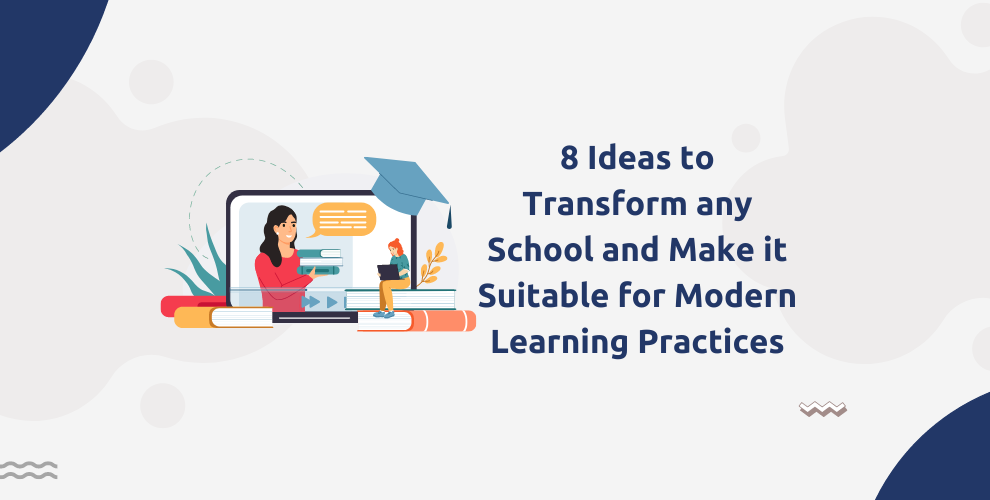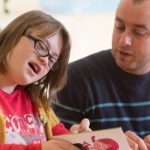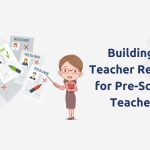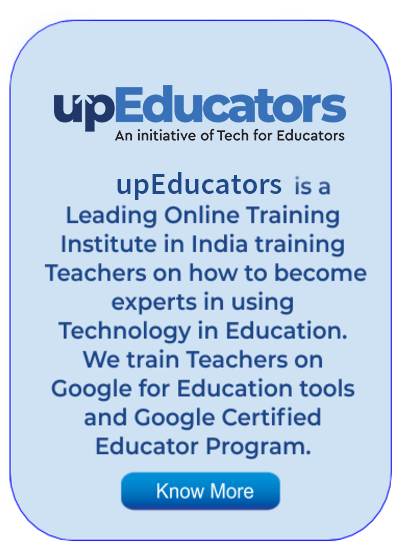A public school was known as a prestigious school that focused on traditional skills and values such as rote memorization, standardized testing, and strict discipline under the old principal. However, this made students bored and unengaged, leading to losing students to other schools.
As the new principal joined the campus, the school administration was asked to invest in professional development for teachers, involving parents in the learning process, and implementing modern learning strategies to transform the school into an innovative learning environment. This led to more engaged students and successful graduates.
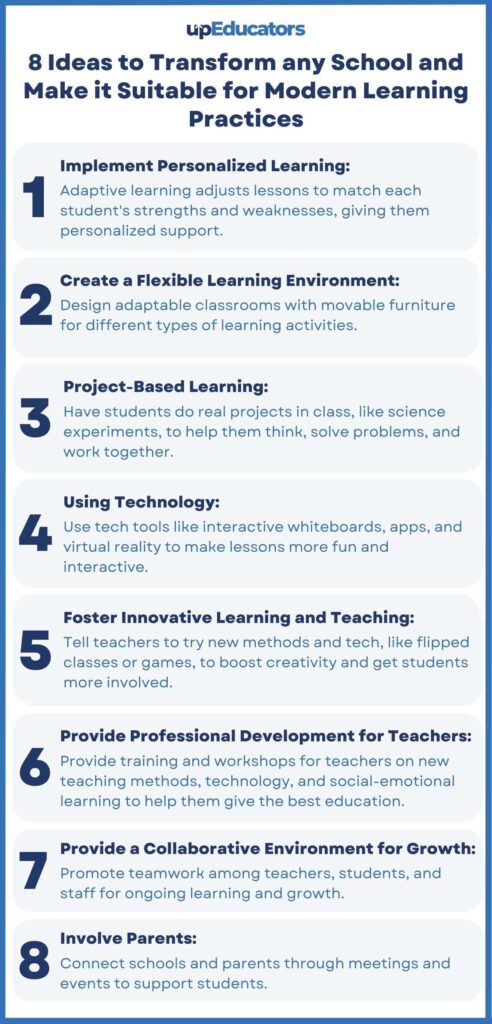
Modern teaching practices are essential for learning in today’s time and age. Schools that do not invest in these modern teaching practices lag behind. In this blog, we discuss how any school can transform itself and adopt modern teaching practices by following these 8 simple steps.
Implement Personalized Learning
Implementing Personalized Learning can certainly help transform a school and make it more suitable for modern learning practices. Personalized Learning refers to an approach to education that tailors the learning experience to the unique needs, interests, and abilities of each student. It allows teachers to better understand the unique strengths, weaknesses, and learning styles of each student, and tailor instruction accordingly. This can help students who may struggle with traditional teaching methods to better engage with and understand the material
For example: In Mrs. Dixit’s classroom, personalized learning thrived. She implemented a digital platform where students could set their learning goals and preferences. Each student received a tailored curriculum and resources based on their needs and interests. As a result, Johnny, a struggling reader, flourished with audio books, while Sarah, a visual learner, excelled with interactive simulations.
Create a Flexible Learning Environment
Creating a Flexible Learning environment can indeed help transform a school and make it more suitable for modern learning practices. A flexible learning environment is one that allows for a variety of teaching and learning styles, can adapt to changing needs, and promotes collaboration and creativity.
A Flexible Learning environment can help move away from a traditional teacher-centred approach to a student-centred one. It allows for different teaching and learning styles that cater to each student’s needs and preferences.
For example: In Ms. D’Souza’s classroom, a flexible learning environment thrived. She arranged the classroom with movable furniture to accommodate individual work, small group discussions, and whole-class activities. Students had access to various learning resources, including technology, books, and art supplies, allowing them to explore topics in their preferred style while fostering collaboration and creativity.
Project-based Learning
Implementing Project-based Learning (PBL) can be an effective way to transform a school and make it more suitable for modern learning practices. PBL is a teaching method that emphasizes active, student-centred learning through the completion of real-world projects or challenges.
Project-based Learning puts students at the centre of their own learning experience. It allows them to actively engage with the material, ask questions, and collaborate with peers. This approach can help to increase student motivation and engagement, leading to better learning outcomes.
It also requires students to think critically, analyze information, and make informed decisions. These are essential skills for success in the 21st-century workforce, where problem-solving and innovation are highly valued.
For example: In Mr. Ramesh’s classroom, project-based learning took flight. The students were tasked with addressing an environmental issue in their community. They researched, planned, and executed solutions collaboratively. Through hands-on experiences and presentations, students developed problem-solving skills, deepened their understanding of environmental challenges, and felt empowered to make a positive impact in the world.
Using Technology
Technology provides students with instant access to information from around the world. This can help to deepen their understanding of subjects and expand their knowledge beyond the traditional classroom setting.
Additionally, technology is an essential part of modern life and work. By integrating technology into the classroom, students can develop digital literacy skills that will be invaluable in their future careers.
Moreover, technology allows for personalized learning experiences that can be tailored to meet the individual needs and abilities of each student. Adaptive learning platforms can adjust to a student’s pace and level of understanding, helping to ensure that they are challenged but not overwhelmed.
For example: In Mrs. Bhandari’s classroom, technology became a powerful learning tool. She introduced Google Earth virtual field trips to explore historical sites, taking students on immersive journeys through different eras. With interactive quizzes and digital resources, students engaged with the material at their own pace, fostering curiosity and enthusiasm for history like never before.
Foster Innovative Learning and Teaching
Innovative Teaching and Learning can encourage creativity by allowing students to explore new ideas and express themselves in new ways. This can help to foster a love of learning and a passion for knowledge. Furthermore, it can emphasize critical thinking by encouraging students to ask questions, challenge assumptions, and analyze information. This can help to develop their problem-solving skills and prepare them for the complex challenges of the modern world.
For example: In Mr. Roberts’ classroom, innovative teaching sparked curiosity. He introduced a “Genius Hour” where students could explore their passions and present their findings creatively. One student developed a robot to assist people with disabilities, another composed a song about climate change. The class embraced individuality, and the joy of learning soared, creating future innovators.
Provide Professional Development for Teachers
Providing Professional Development for Teachers can be a powerful way to transform schools and make them more suitable for modern learning practices. Professional Development can help teachers stay up-to-date on the latest research, techniques, and technologies in their field. This can help them to provide the most current and effective instruction to their students. It can also provide teachers with opportunities for growth and advancement, whether through leadership roles or advanced training in specific areas. This can help to keep teachers motivated and engaged in their work.
For example: At Jefferson High School, the administration recognized the importance of professional development. They organized a week-long workshop led by education experts, focusing on integrating technology into the classroom effectively. Teachers learned to use interactive apps, online collaboration tools, and data-driven instruction. The teachers returned inspired, transforming their classrooms into dynamic, tech-infused learning spaces.
Provide a Collaborative Environment for growth
A Collaborative Environment can encourage teamwork among students and teachers, allowing them to work together to solve problems, share ideas, and support each other in their learning. It can also prepare students for the future by teaching them important skills such as communication, teamwork, problem-solving, and adaptability. These skills will be invaluable in the modern workforce, where collaboration and innovation are highly valued.
For example: In Ms. Yeshi’s classroom, a collaborative environment thrived. She divided her students into small groups for a week-long science project. Each group was responsible for researching, designing, and presenting a unique experiment. The students embraced teamwork, sharing ideas, delegating tasks, and supporting one another, fostering a spirit of cooperation and growth.
Involve Parents
Involving Parents can increase parental engagement in their child’s education, which has been shown to have a positive impact on student achievement and well-being. It can also enhance communication between the school and families, helping to ensure that everyone is informed and involved in the learning process. Furthermore, involving parents can encourage collaboration between the school and the community, allowing for the sharing of resources, expertise, and support.
For example: In Mrs. Ahmad’s classroom, parent involvement was prioritized. She organized monthly “Parent Partnership Days” where parents visited the classroom to observe lessons and participate in interactive activities with their children. This strengthened the home-school connection, fostering a supportive learning environment and empowering parents to be active partners in their child’s education.
Transforming any school to make it suitable for modern learning practices requires a comprehensive approach that involves various stakeholders, including teachers, administrators, students, parents, and the wider community. The points discussed above provide a roadmap for schools to become more modern and innovative. By embracing these ideas and implementing them effectively, schools can better prepare students for success in the 21st century and equip them with the skills and knowledge they need to navigate an ever-changing world.
If you want to become a teacher or a principal to take your school on a journey of transformation, then the Professional Certificate in Innovative Teaching Practices course by upEducators is the right choice for you. With this course, you will be able to become an expert teacher/principal to learn, teach and apply innovative and modern teaching practices to transform your school.
Author: This article is written by Samiya Rashid for upEducators blog.
